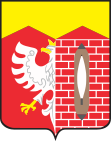Zelów
| Zelów | ||
|---|---|---|

|
|
|
| Basic data | ||
| State : | Poland | |
| Voivodeship : | Łódź | |
| Powiat : | Bełchatowski | |
| Gmina : | Zelów | |
| Area : | 10.8 km² | |
| Geographic location : | 51 ° 28 ′ N , 19 ° 13 ′ E | |
| Residents : | 7611 (June 30, 2019) | |
| Postal code : | 97-425 | |
| Telephone code : | (+48) 44 | |
| License plate : | EBE | |
| Economy and Transport | ||
| Street : | Bełchatów - Szadek | |
| Next international airport : | Łódź Airport | |
Zelów [ ˈzɛluf ] ( German Zelow , 1943–1945 Sellau ) is a city in the Łódź Voivodeship in Poland . It is the seat of the town-and-country municipality of the same name with 14,995 inhabitants (as of June 30, 2019).
geography
The city is located about 50 kilometers south of the voivodeship capital Łódź .
history
The first permanent settlement on the site of today's Zelów dates from the 13th century. The first mention of the place comes Szelyów from the year 1402. 1412 the village was named Szelena mentioned later Zeliów . During the Third Partition of Poland , Zelów became part of Prussia in 1795 . On December 21, 1802, around 100 Czech-speaking families of the descendants of the Bohemian brothers , who emigrated to Silesia after the Battle of White Mountain (especially after the First Silesian War), acquired the estate and dominated the place for over 100 years. With the creation of the Duchy of Warsaw , Zelów became part of it and in 1815 it became part of Congress Poland . A total of 4,000 Czechs lived in Zelów and the surrounding area ( Pożdżenice , Nowa Wola, Ignaców, Weronika, Faustynów, Józefatów, Petronelów, Bujny Szlacheckie). The Protestants were formally affiliated to the Evangelical Reformed Church. In 1817 Jan Fabry from Hungary became the first pastor. In the second half of the 19th century the number of other ethnic groups increased: Poles, Germans, Jews. After the arrival of Karol Kulhavy, Baptism developed in Faustynów, Pożdżenice and Zelów. At the turn of the 20th century, the importance of Catholicism increased and the Reformed congregation split between the Free Evangelical Reformed Church, the Bohemian and Moravian Brethren , and Methodists. At that time there were around 2,200 Czechs in Zelów (and around 800 in the area), 800 Jews, 500 Poles and 90 Germans.
At the end of the First World War , Zelów became part of Poland. At the same time, several hundred Czechs moved to Czechoslovakia , but Zelów remained the second largest Czech society in Poland after the Wolhynientschechen . Much more of the Czechs emigrated to Czechoslovakia after World War II . Zelów received its town charter in 1957, three years after it was recognized as an urban-type settlement . In 1970 the state-owned company Farna established cotton processing companies in the village, which became the largest in Europe.
In 1976 the city and the municipality were merged into one administrative unit.
On March 11, 1998, Zelów was visited by Václav Havel . Zelów remains the most important center of the Czech minority in Poland (2,831 people in Poland in 2011) as well as the Evangelical Reformed Church in Poland (Zelów is the largest of the 8 parishes of this church with around 500 members). In addition to Zelów, the Czechs in the Zelów municipality also live in Ignaców and Zelówek.
coat of arms
Zelów received the coat of arms on July 21, 1973.
Town twinning
Since 1993 there has been a town partnership with the town of Neuenhaus .
Religions
Today Zelów is home to the largest Protestant Reformed congregation in Poland with 500 members.
The church has the only handbell choir in Poland.
local community
The town itself and 35 villages with school boards belong to the town-and-country community (gmina miejsko-wiejska) Zelów.
Culture and sights
Museums
There is a small history museum in the Protestant church, over which Václav Havel took over the patronage.
Buildings
- the Catholic Church
- the Baptist Church
- the Classicist Church of the Bohemian Brothers from 1828, which was restored in 1971
- the wooden weaver's house from the 19th century.
Web links
- Zelów . In: Filip Sulimierski, Władysław Walewski (eds.): Słownik geograficzny Królestwa Polskiego i innych krajów słowiańskich . tape 14 : Vorovo – Żyżyn . Walewskiego, Warsaw 1895, p. 566 (Polish, edu.pl ).
- Official website of the city (Polish, German, English)
- Short article about the city (German)
- Articles on the Czech language in Poland , including by Zelów (Polish)
Individual evidence
- ↑ See order on the change of place names in Reichsgau Wartheland, No. 62 of May 18, 1943
- ↑ www.neuenhaus.de twin cities
literature
- Philipp Lipiński: Mniejszość czeska w Zelowie. Opracowanie monograficzne (The Monography of Czech Minority in Zelów) . Poznań 2013 (Polish, online ).


